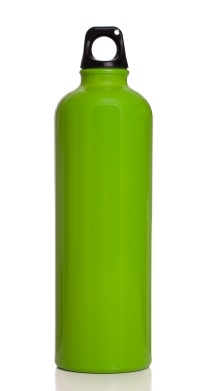
Drink, refill, repeat. This easy, seemingly harmless sequence may quench your thirst throughout the day, but water’s probably not the only thing you're guzzling down, research shows.
According to Dr. Kunle Kassim, a professor of microbiology at Howard University Medical School who’s spent years studying unsafe water conditions in developing countries, the lip of any type of bottle is one of the most bacteria-prone items we encounter each day. His findings may lead you to reevaluate the integrity of the container at your desk.
Consider this: No matter how much hand sanitizer we use, our fingers are inevitably exposed to millions of germs every day (doorknobs and keyboards are pretty serious culprits). Every time we twist open the cap to our bottle, we enable the exchange of those bacteria—including E. coli and staph—onto the bottle, into our water, and ultimately into spots of the body where they don’t belong.
“All of these bacteria already live on the skin,” Kassim says. “As long as they stay on the outside of the skin, they’re fine. It becomes harmful if they get away from where they’re supposed to be.”
While most forms of E. coli are harmless, certain strains can cause diarrhea and stomach pains if ingested. The same characteristic applies to staph, which induces vomiting, and a bacteria called pseudomonas aeruginosa—P. aeruginosa for short—which, depending on one’s health, could introduce blood infections.
Many people won’t ever be affected by the exposure; the side-effects vary from person to person. For cardiac, HIV/AIDS, or cancer patients, some diabetics, and the elderly, the risks are far more substantial. These conditions weaken the type of immunity in healthy bodies that fight off the bad guys, resulting in infection, Kassim says. Exposure to P. aeruginosa in cystic fibrosis patients could result in pneumonia or other lung infections.
“If you share your water bottle with somebody, drink from a bottle and don’t clean it, or let it sit around, the bacteria can grow. Then, when you drink it again, you introduce large amounts into the body that can become risky,” he says.
To combat the persistent organisms, Kassim says exposure to sun may help; the combination of heat (higher than 60 degrees), ultraviolet rays, and oxygen create a bacteria-killing effect. But since it’s probably not particularly thirst-quenching to drink hot water, disinfecting your bottle at least once a day is your best bet.
Here are three disinfecting solutions you can make at home, all of which should soak in the bottle for 10 to 15 minutes and rinsed thoroughly afterwards. Let the bottle completely air-dry, as towels can cause further contamination.
• Nine parts water, one part household bleach
• Nine parts water, one part table salt
• Eight parts water, one part baking soda, one part vinegar (best for killing odors)
Subscribe to Washingtonian
Follow Well+Being on Twitter
More >> Health | Top Doctors | Well+Being Blog












